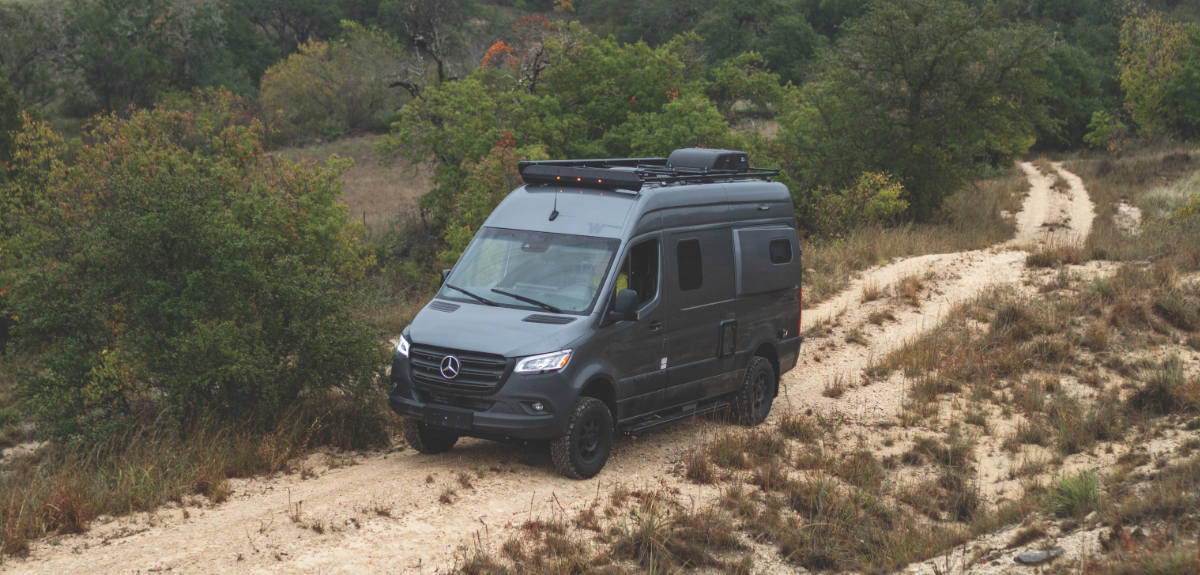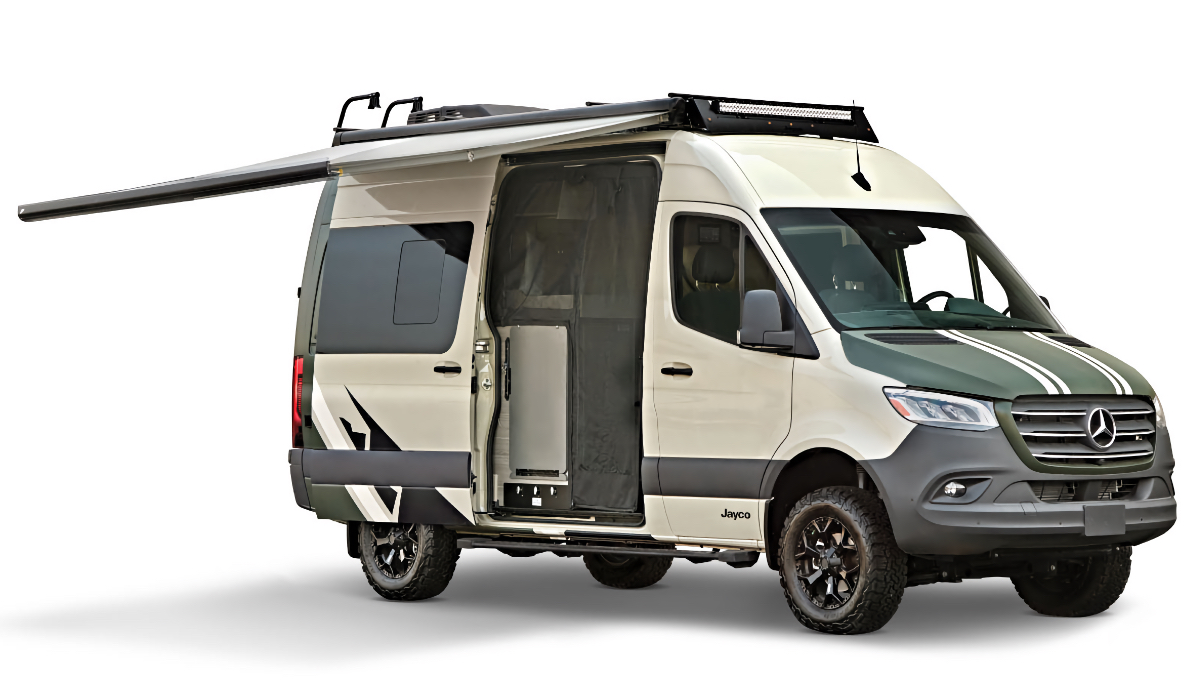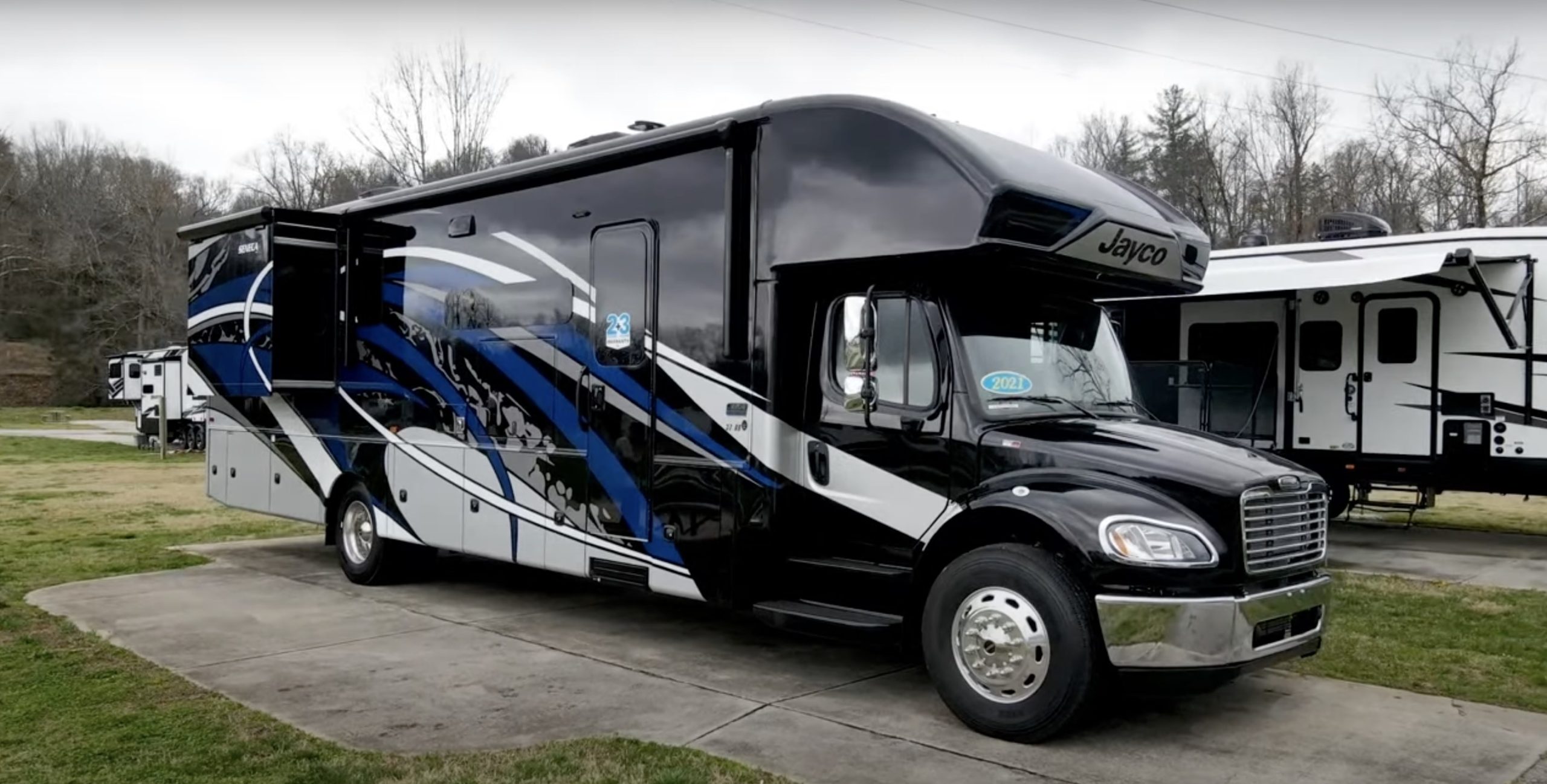Class B Review: Winnebago Revel 4×4
Image Caption:
The snow was melting due to a recent thaw, but that didn’t stop us from taking Winnebago up on a last-minute offer to get our hands on the new Revel 4×4 motorhome for a cold-weather New England test. While we were raring to test this puppy out, most of the RV-friendly destinations in New England were unavailable at the time. So, we reached out to Pine Acres Family Camping Resort (http://pineacresresort.com) in Oakham, Massachusetts. Pine Acres used to be a ski resort, and the trails were converted to campsites on the mountain with cabins and dirt mountain roads which, of course, are not usually accessible late in the calendar year.
The Winnebago Revel, a 4×4 Class B motorhome built on the Mercedes-Benz Sprinter diesel van, is available from the factory with electronic-shift four-wheel drive. It is not your everyday motorhome and is designed with outdoor adventurers in mind, so its layout and equipment are a departure from the norm.
Inside
The Revel interior is modern and no-nonsense, befitting its adventurous spirit – this Class B is equally at home on a snowy ski mountain as it is on a hot, sunny beach. The color palette is designed to lighten the interior and help make scuffs and dirt less visible, a prerequisite for such a motorhome. There are four colors: lime green, gray, white and black. All the surfaces from floor to ceiling are designed for easy cleanup, which was really appreciated since we managed to track in large amounts of snow and mud.
Sleeps
The bed, which is longer than the motorhome is wide, extends into two fiberglass side panels (replacing the rearward OEM windows) that flare out from the sides of the van, giving the bed a total length of 79 inches. The mattress, at 49 inches wide, is comfortable, and the window at the head of the bed provides a nice breeze. Reading lamps and charging ports are readily accessible.
The bedroom is interesting. Initially, the lack of any cabinetry was puzzling. But we soon realized how functional the space was; the bedroom doubles as a gear garage, so the openness of the space allows any type of gear to be stowed, albeit on the floor. Since most outdoor adventurers aren’t afraid to stash their gear in the aforementioned duffle bags and backpacks, occupants will feel right at home.
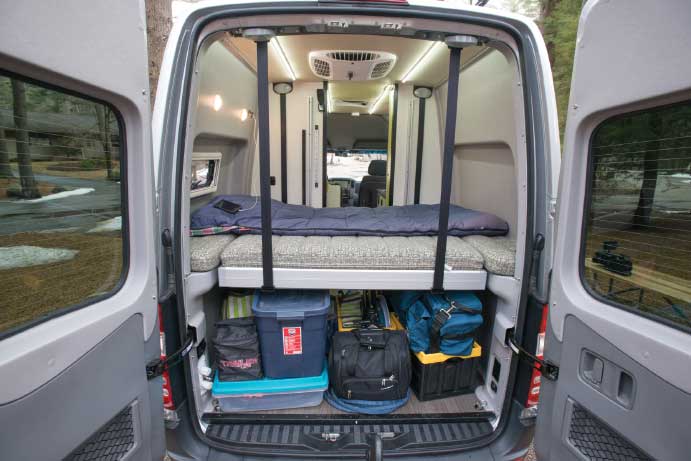
The motorhome’s hinge-mounted holdbacks keep rear doors open 90 degrees, allowing clear access to the cargo area.
Galley & Storage
The galley is built with outdoor living in mind and, as such, is minimalistic. A Dometic stainless-steel sink with glass cover and foldaway faucet is ideal, providing additional prep space when the sink isn’t needed. A fold-up 16-by-13-inch countertop extension adds a bit of extra space to the 19-by-36-inch galley. An interesting feature is a table that folds down from the kitchen cabinet to the outside of the motorhome, set up in a flash by screwing on a single leg. However, the spring-loaded clips that hold the table in the stowed position were a bit noisy while on the road.
The only cooking appliance is an electric single-burner induction cooktop, which further emphasizes the outdoor living/cooking concept. Below the cooktop is a compressor-driven 2.5-cubic-foot refrigerator freezer, along with three drawers for kitchen necessities. Above is a single overhead cabinet. All the cabinets lock with push-button hardware. There’s also an overhead cabinet above the dinette for additional storage.
Moving aft you’ll find a tall, narrow, counter-depth pantry, which rounds out the fixed storage in the Revel. While fixed storage is at a premium, the entire rear third of the interior is occupied by a power-lift bed, which doubles as a storage garage. The entire center section of the bed lifts electrically to the ceiling, creating a cavernous space for gear and toys, and is accessed from the inside or by opening the rear doors. Once again, most outdoor adventurers are carrying gear in duffels, backpacks, etc., which are easily stowed here. Longer items can even sit in the middle of the floor and extend as far forward as the dashboard.
Living Area
Stepping into the side door, the Revel’s interior layout is efficiently designed, with few extras. The living space has seating for three or four people, but it’s really designed for two. A folding table is the center of activity and can be used for dining or as a desk while underway or in camp. A window next to the table allows for enjoyment and contemplation of the scenery outside, or added ventilation when the temperature is on the rise.
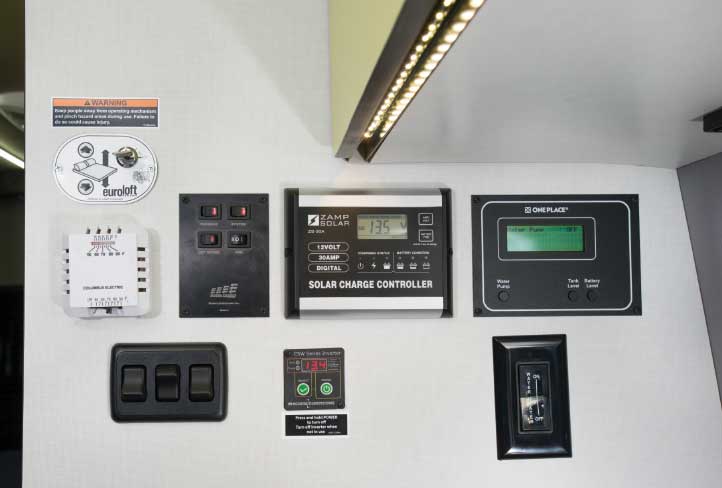
Control panels are centrally located and provide simple at-a-glance reference.
Bathroom
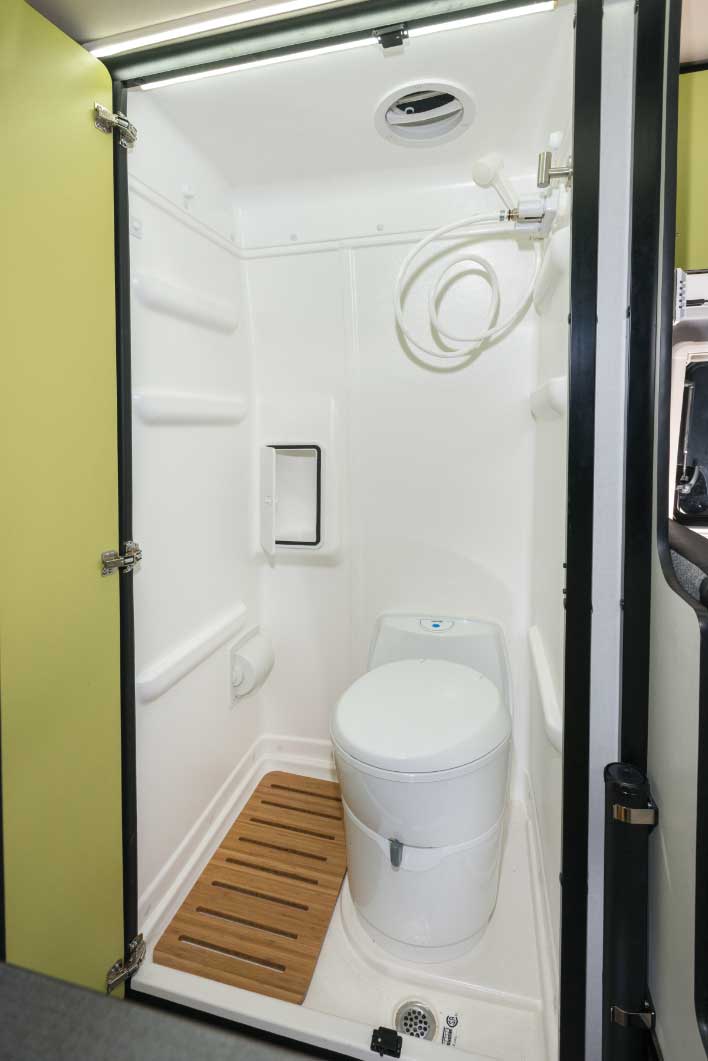
The Revel’s wet bath is roomy and has a cassette toilet that swivels for easier access is behind a bifold door.
The bathroom is large by Class B motorhome standards: 26 inches deep, 30 inches wide and 71 inches tall, and has multiple functions – ideal for this motorhome’s likely use. A Thetford C220 cassette toilet with push-button electric flush has a seat that swivels 90-degrees, so taller folks can have the extra space of the aisle, if needed. A compartment door on the exterior leads to Thetford’s exceptionally designed removable cassette tank, making dumping clean and straightforward.
The bathroom doubles as a gear dryer, with slatted racks that slide onto side-oriented detents, capitalizing on a Ventline pop-up exhaust in the ceiling, which draws air up through the gear from under the door. (Firefighters will recognize the similarity to hose dryers.) Once the bifold door is closed, moisture and odors are ejected through the roof. To take a shower, the racks are pulled out and set aside. A removable closet bar in the bathroom can be used for drying hanging clothes or storage.
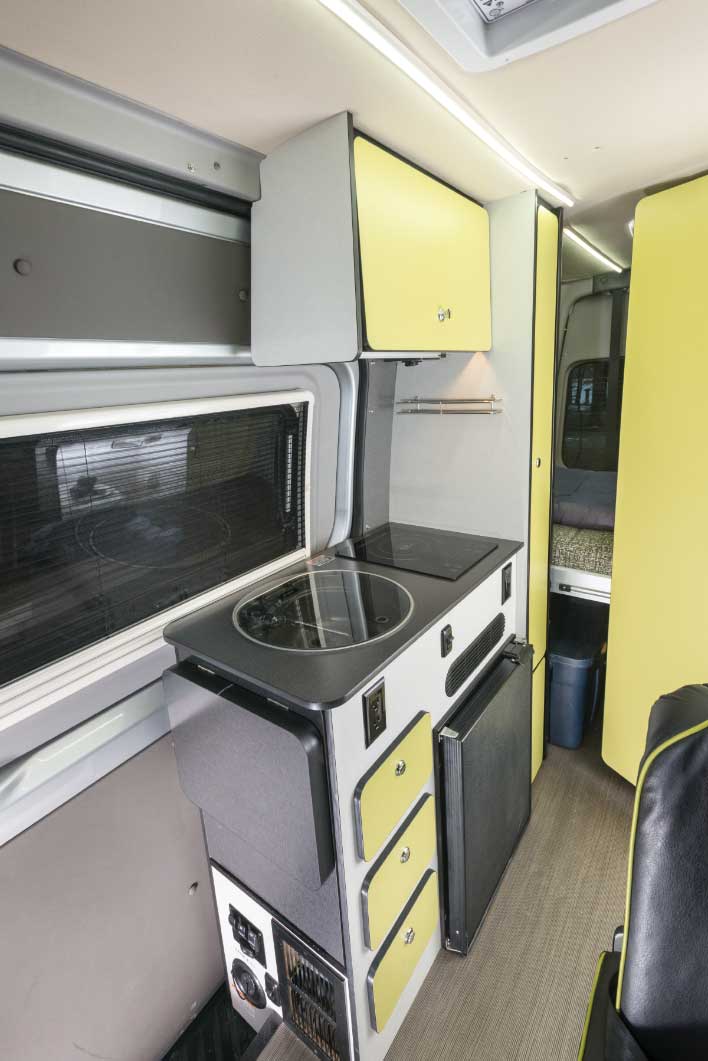
Minimalistic galley includes stainless-steel sink with glass cover and foldaway faucet, single-burner induction cooktop and 2.5-cubic-foot refrigerator. Fold-up countertop extension adds prep space.
The Cockpit
Both front cockpit seats rotate toward the living area and are comfortable and adjustable. The standard Sprinter rubber floormat adorns the front, while the remaining flooring is a super-tough nonskid vinyl with a weathered-wood gray appearance. The single, forward-facing dinette seat has two seat belts, but it’s on the tight side for two.
Special Features
The Revel, unlike most motorhomes, does not have any TVs, or even TV connections. With Millennials being the target generation for this product, Winnebago has assumed that owners will choose to stream their entertainment and information using portable smart devices. RAM Tough-Track mounts are strategically located throughout the motorhome to accept portable device brackets. USB, 12-volt DC and 120-volt AC receptacles are also plentiful and placed near the Tough-Track mounts.
Outside
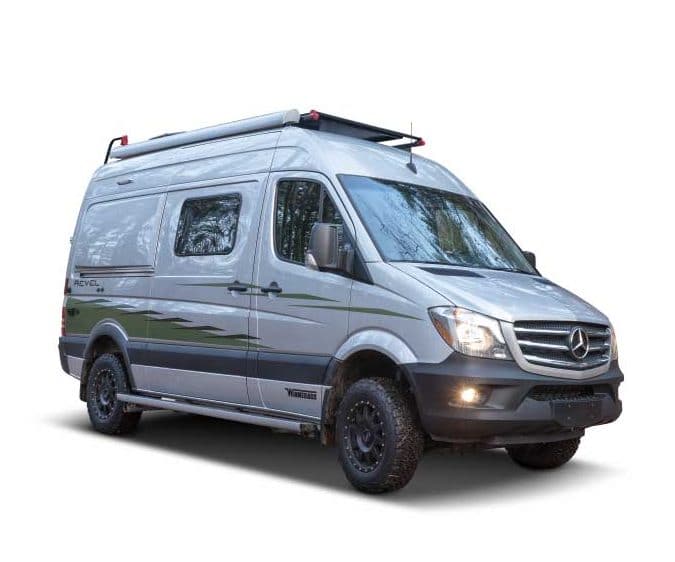
Winnebago Industries, 641-585-3535, https://winnebagoind.com
Since its introduction in the fall of 2017, the Revel has been getting lots of attention, as this motorhome screams adventure. At least two online groups for owners and want-to-be owners have formed, frequently sharing trip information and modifications made to their motorhomes.
Like most serious 4x4s, the Revel is primed for modifications that individualize ownership. We have seen owners upgrade interior features, the suspension, remove the air conditioner, design storage bins for the rear … the list goes on. The exterior of the Revel looks ready to go off road from the get-go.
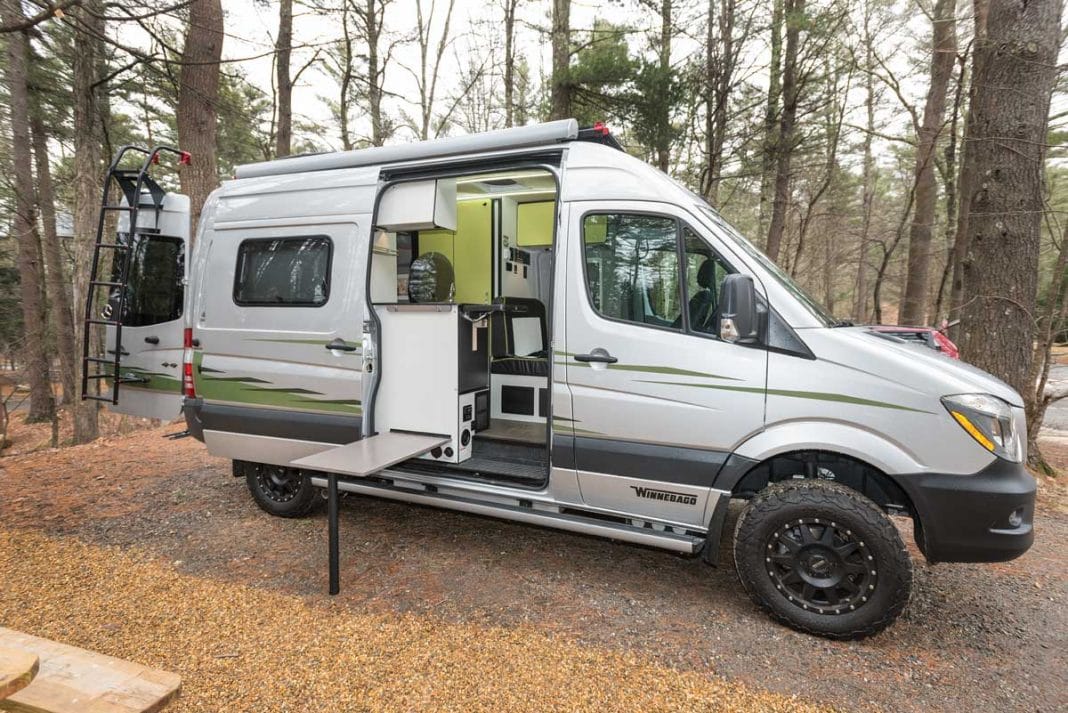
From its aggressive styling to 4WD capabilities to a fold-down table for campsite dinner, the Revel is all about enjoying the outdoors.
Materials & Construction
Two paint colors are available: Pebble Gray and Silver Forest, along with available deluxe graphics for a sportier look. Buyers can also opt for a more understated look sans the vinyl graphics. Beyond the graphics, the conventional Mercedes black side molding extends down both sides, with sporty black front and rear bumpers. The front clip is sleek, with swept headlamp buckets and the chrome grille with that large, distinctive Mercedes-Benz badge in the middle, which instantly elevates the status of this off-roader.
Notable Equipment & Features
The back doors of the Sprinter typically open 270 degrees and have magnetic holdbacks attached to the sides of the van. While the Revel maintains these holdbacks, the side bed flares prevent the metal doors from being attracted to the magnets and holding open. However, the hinge-mounted holdbacks still keep the doors open to 90 degrees, allowing unfettered access to the rear cargo area, and a great vantage point to view the beautiful vistas outside from the bed. An outside-access shower is located just inside the back door, with a quick-connect coiled hose and nozzle.
The Revel’s utilities are a little different from mainstream motorhomes, primarily because of its size, but also to help keep the plumbing from freezing up in cold conditions. The water system is different but functional; no city-water hookup here, as the systems are only supplied by the onboard tank. There are two water fills, one each for a pressurized source and a gravity fill, both located on the galley cabinet inside the sliding door. The Dometic sink is connected to a macerator pump for drainage into the gray tank and is operated by a momentary switch on the galley cabinet. This setup discourages leaving the water running since it won’t drain unless the macerator switch is held in the on position. A black-water tank is not necessary with the use of a cassette toilet, but the gray-tank dump valve is located near the driver’s side rear wheel.
Comfort heating and hot water are provided by a diesel-fired Espar hydronic system. The efficiency of this system is exceptional, and it kept the motorhome nice and warm on those cold New England nights. The main burner unit is below the dinette floor, and the circulator routes the antifreeze through a tank and heat exchangers for hot water and comfort heat respectively.
There is no AC generator on the Revel. Instead, it is equipped with three Group 31 AGM deep-cycle batteries, a 2,000-watt power inverter and the previously mentioned solar panels. The 30-amp shorepower cord is removable and is stowed on the floor in the rear of the unit. While the roof air conditioner will not operate without shorepower, the refrigerator and induction cooktop work nicely. Everything else, including the Espar heating system, works on 12 volts DC.
Exterior Storage Space
Patio life in the wilderness is an indulgence and is well served by the Revel, thanks to the Carefree 118-inch Freedom 12-volt-DC-powered awning, fold-out galley table, and exterior 120-volt AC and 12-volt DC receptacles.
The Revel’s Mercedes 4×4 Sprinter base sports almost 8 inches of ground clearance from the factory, but Winnebago adds Method Race Wheels and terrain-eating BFGoodrich All-Terrain T/A KO2 sneakers, which not only add a bit of ground clearance but give the profile a serious off-road look.
The Revel is equipped with a roof-length cargo rack with a rear-door, removable roof access ladder that stows on a bracket and attaches to the rack on the driver’s side for access. That’s a good approach, but the space is occupied by dual solar panels and the rooftop Coleman air conditioner, making it minimally useful for cargo. A Fiamma kayak rack is available for the driver’s side of the cargo rack. Some owners have removed the air conditioner and added another roof vent in addition to the MAXXAIR vent in the galley to make the roof rack more usable for cargo.
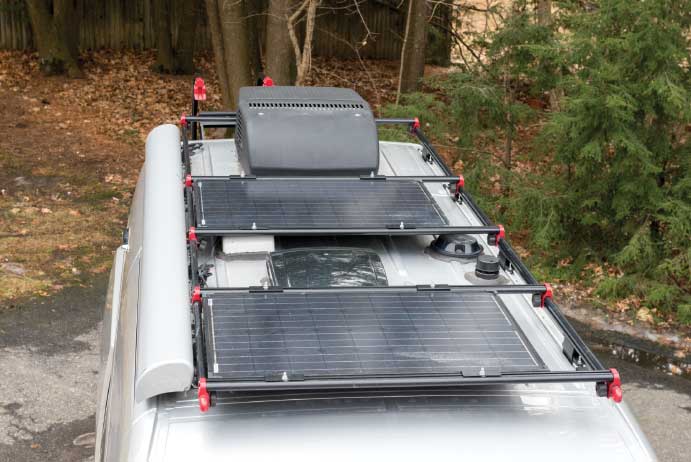
The Winnebago Revel is equipped with a roof-mounted cargo rack with removable access ladder. Cargo space is limited, though, by the dual solar panels and Coleman air conditioner. Some owners have opted to remove the A/C to allow for more cargo space.
Operation and Ease of Use
The Revel’s performance on and off-road is quite good, taking the vehicle’s design into account. Highway handling is decent and the steering is responsive. Acceleration is adequate, again understanding that this is a motorhome. Wind noise during our journey was less noticeable than expected, figuring the roof apparatus would be noisy. Road noise also wasn’t bad, considering the all-terrain tires.
Engaging the four-wheel drive is a push-button affair, and we put the Revel through some paces at Pine Acres. The snow-covered trails leading up the mountain weren’t a challenge, and even though there wasn’t a huge amount of snow, the trails hadn’t been cleared, and the ground was soft in spots, so we were able to test traction in mud and snow, and were impressed at how this motorhome handled it all.
Final Thoughts
The Winnebago Revel is an excellent sport-utility motorhome for those looking for outdoor adventure and to participate in sports. The Revel’s flexible (open space) bedroom allows the unit to be used to carry gear of multiple sizes, while still having many of the comforts of home. The build quality is typical for Winnebago: solid and functional, with quality systems integrated into the mix.
Winnebago studied the target demographic for this motorhome, so it doesn’t necessarily fit into a “typical” category. The Revel is a platform that can be customized to suit personal tastes and lifestyles. It can be a surf-fishing sand runner on the Cape Cod National Seashore, a mobile ski lodge in Colorado, a portable photography studio in Arizona, or can carry all the gear for the intrepid mountain climber headed for Yosemite’s El Capitan.
If you’re looking for a motorhome that can take you to remote places, the Revel should be at the top of your list.
Manufacturer’s Specs
Chassis
Model Mercedes-Benz Sprinter 319 KA 4X4 3665
Engine 3.0L 6-cylinder diesel
SAE Hp 188 @ 3,800 rpm
Torque 325 lb-ft @ 1,400 rpm
Transmission Automatic 5-speed
Axle Ratio 3.923:1
Tires LT245/70R17 LRE
Wheelbase 144″
Brakes Front/Rear Ventilated Disc/Disc
Suspension Front/Rear Strut/Leaf
Fuel capacity 24.5 gal
Fuel Economy 17 mpg
Warranty 3-year/36,000 mile plus 5-year, 100,000-mile powertrain
Coach
Exterior Length 19′ 8″
Exterior Width 7′ 1″
Exterior Height with A/C 10′ 3″
Interior Width 6′ 7″ (at the bed)
Interior Height 6′ 3″
Construction Steel body, composite floor
Freshwater Capacity 21 gal
Black-water Capacity 5 gal (cassette toilet)
Gray-water Capacity 21 gal
Water-heater Capacity Instantaneous
LP-gas Capacity N/A
Air Conditioner (1) 13,500 Btu
Furnace Hydronic 17,000 Btu
Refrigerator 2.5 cu-ft
Inverter/Charger 2,000-watt/45 amp
Batteries (1) 12-volt chassis, (3) 12-volt house AGM
AC Generator N/A
MSRP $134,799
MSRP as Tested $142,535
Warranty 12 months/15,000 miles
Wet Weight
(Water and water heater, fuel, LP-gas tanks full; no supplies or passengers)
Front Axle 3,820 lbs
Rear Axle 3,660 lbs
Total 7,480 lbs
Chassis Ratings
GAWR, F/R 4,101 lbs/5,360 lbs
GVWR/GCWR 8,550 lbs/13,550 lbs
ROCCC 1,070 lbs (deduct weight of passengers for net cargo capacity)
GAWR Gross Axle Weight Rating
GVWR Gross Vehicle Weight Rating
GCWR Gross Combination Weight Rating
ROCCC Realistic Occupant and Cargo Carrying Capacity (full water, no passengers)

